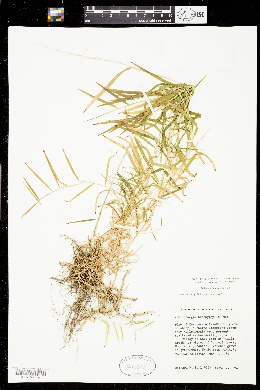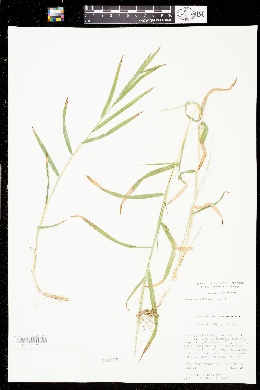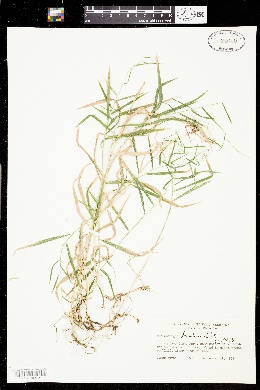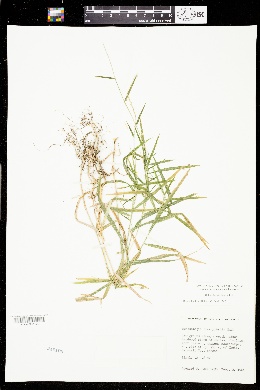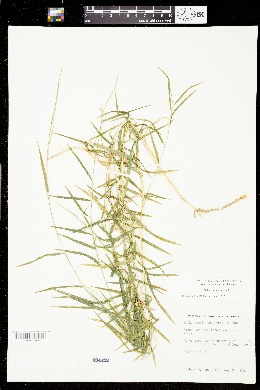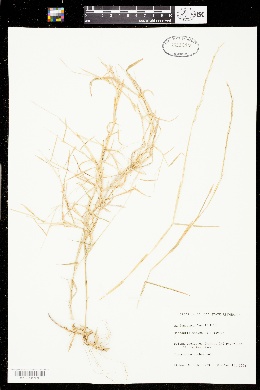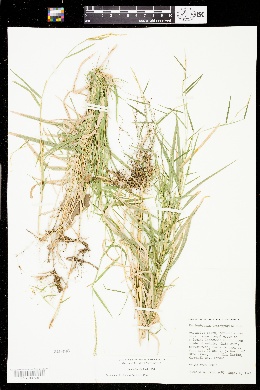Muhlenbergia bushii
|
|
|
|
Family: Poaceae
Nodding Muhly
|
Plants perennial; rhizomatous, not cespitose. Culms 30-100 cm tall, 1-2 mm thick, herbaceous; internodes smooth, shiny, usually glabrous throughout. Sheaths glabrous, usually smooth, occasionally scabridulous distally; ligules 0.2-0.6 mm, membranous, truncate, ciliolate; blades 5-15 cm long, 2-7 mm wide, flat, glabrous abaxially, glabrous, smooth or scabridulous adaxially, those of the lateral branches often shorter and narrower than those of the primary branches. Panicles terminal and axillary, 4-15 cm long, 0.1-0.7 cm wide, narrow, not dense; axillary panicles common, partly included in the sheaths; branches 0.5-4 cm, ascending to appressed; pedicels 1-4 mm, glabrous. Spikelets 2.6-3.3 mm, not imbricate along the branches. Glumes subequal, 1.4-2 mm, about 1/3-2/3 as long as the lemmas, smooth or scabridulous distally, 1(2)-veined, acuminate or acute, unawned or awned, awns to 1 mm; lemmas 2.6-3.3 mm, narrowly lanceolate, usually hairy on the calluses and lower 1/3 of the margins and midveins (rarely glabrous), hairs 0.5-1 mm, apices scabridulous, acuminate, unawned or awned, awns 0.5-7 mm; paleas 2.2-3.1 mm, shorter than the lemmas, narrowly lanceolate, intercostal region shortly pilose on the basal 1/3, apices acuminate; anthers 0.3-0.6 mm, yellow. Caryopses 1.5-1.8 mm, fusiform, brown. 2n = 40. Muhlenbergia bushii grows in sandy alluvium, open thickets, dry woodlands,and flood plains, at elevations of 10-250 m in the central portion of the contiguous United States. Early season plants, in which the axillary panicles are poorly developed, can be distinguished from those of M. mexicana by their shiny internodes and the tendency of the blades on the secondary branches to be shorter and narrower than those on the main branches. Perennial rhizome-bearing herb 30 cm - 1.15 m tall Leaves: with open sheaths that are hairless and smooth but sometimes minutely rough near the tip, and flat-topped ligules that are 0.2 - 0.6 mm long, transparent near the base, and lined with hairs along the margin. The blades are 5 - 15 cm long, 2 - 7 mm wide, flat, hairless beneath, and hairless and smooth or sometimes minutely rough above. Blades on lateral branches usually shorter and narrower than blades on primary branches. Inflorescence: terminal and axillary, spike-like and branched (panicle), 4 - 15 cm long, 2 - 7 mm wide, narrow, with ascending to appressed branches 0.5 - 4 cm long. The axillary panicles are partly surrounded by sheaths. Fruit: a brown, spindle-shaped caryopsis, 0.5 - 1.8 mm long. Culm: 30 cm - 1 m long, 1 - 2 mm across, with shiny internodes that are hairless and smooth but sometimes minutely rough near the base. Spikelets: 2.6 - 3.3 mm long, not overlapping along the branch, borne on a hairless stalk 1 - 4 mm long. Glumes: nearly equal, 1.4 - 2 mm long, usually single-veined, smooth or minutely rough near the pointed tip, sometimes ending in an awn 0.5 - 7 mm long. Florets: one per spikelet, with yellow anthers 0.3 - 0.6 mm long. Lemma: three-veined. Palea: shorter than the lemma (2.2 - 3.1 mm), narrow lance-shaped with a pointed tip, two-veined, with the lower one-third short-haired between the veins. Similar species: The following species also have shiny, mostly hairless culms. The glumes of Muhlenbergia schreberi are missing or minute, and those of Muhlenbergia x curtisetosa are unequal and sometimes awned. Muhlenbergia sobolifera is identified by its egg-shaped, sometimes awned glumes and erect to ascending culms that rarely branch. The awned, narrow, 3 - 8 mm long glumes of Muhlenbergia racemosa are much longer than the lemmas and end in a minutely rough awn. Muhlenbergia frondosa has narrow, 2 - 4 mm long, sometimes awned glumes that are shorter than to slightly longer than the lemmas, 0.7 - 1.7 mm long ligules, and 1.6 - 1.9 mm long caryopses. Muhlenbergia glabrifloris has 1.5 - 3.5 mm long, sometimes awned glumes that are shorter than or slightly longer than the lemmas, 0.5 - 1.5 mm long ligules, and 1.2 - 1.4 mm caryposes. Flowering: August to October Habitat and ecology: Shaded terraces along rivers in the lower Kankakee river valley. Occurence in the Chicago region: native Etymology: Muhlenbergia is named after American botanist, Gotthilf Henry Ernest Muhlenberg (1753-1815). Bushii is named after Benjamin Franklin Bush, a 20th century botanist. Author: The Morton Arboretum Much like no. 6 [Muhlenbergia frondosa (Poir.) Fernald]; internodes mostly concealed by the overlapping sheaths; blades grayish-green, stiffish, the larger ones 5-10(-15) cm נ2-5 mm; ligule short, 0.2-0.6 mm; glumes 1.4-2(-2.5) mm, half to two-thirds as long as the lemma; lemma 2.6-3.3 mm, usually awnless or with a minute awn-tip, rarely with an awn to 7 mm; 2n=40. Prairies, plains, and dry woods, adapted to drier habitats than no. 6; Ill. and s. Ind. to Io., Nebr., and Tex. (M. brachyphylla, a preoccupied name) Gleason, Henry A. & Cronquist, Arthur J. 1991. Manual of vascular plants of northeastern United States and adjacent Canada. lxxv + 910 pp. ©The New York Botanical Garden. All rights reserved. Used by permission. From Flora of Indiana (1940) by Charles C. Deam Probably infrequent to rare in the southern part of the state. At a distance it so closely resembles Muhienbergict tenuiflora that it may not be detected. On close observation, however, it is easily separated from this species by its glabrous nodes and infranodes. It is found in low, flat woods and on wooded slopes. I am not well enough acquainted with this species to understand its habitat. .…… Indiana Coefficient of Conservatism: C = 6 Wetland Indicator Status: N/A |













































































